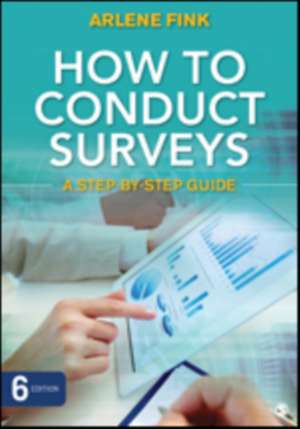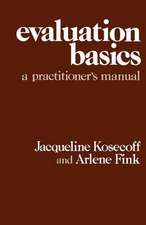How to Conduct Surveys: A Step-by-Step Guide
Autor Arlene G. Finken Limba Engleză Paperback – 15 mar 2016
New to this edition:
- Discussion of validity and reporting of qualitative survey data addresses the values of and “threats” to the validity of qualitative studies, along with guidance on transparently reporting purposes and methods.
- Discussion of margin of error and confidence levels prepares readers to be aware of imperfections in all surveys.
- Coverage on surveys involving children addresses how to design a survey that reaches children, getting reliable and valid information, the differences between doing a survey for young children and doing one for teens, the difference between assent and consent in children, and how to accommodate ethics boards when surveying children.
- Guidance on international surveys takes into account the increased use of smartphones and access to the Internet and helps readers respect cultural differences in designing and asking questions involving international audiences.
- Coverage of the standard survey report checklists now required by many journals, businesses, and educational institutions prepares readers to produce transparent survey reports.
- Many new practice exercises in every chapter promote hands-on learning to develop skills in analyzing, evaluating, and producing information.
Preț: 535.82 lei
Preț vechi: 724.08 lei
-26% Nou
Puncte Express: 804
Preț estimativ în valută:
102.54€ • 106.66$ • 84.65£
102.54€ • 106.66$ • 84.65£
Carte disponibilă
Livrare economică 24 martie-07 aprilie
Livrare express 07-13 martie pentru 25.67 lei
Preluare comenzi: 021 569.72.76
Specificații
ISBN-13: 9781483378480
ISBN-10: 1483378489
Pagini: 224
Dimensiuni: 178 x 254 x 17 mm
Greutate: 0.36 kg
Ediția:Sixth Edition
Editura: SAGE Publications
Colecția Sage Publications, Inc
Locul publicării:Thousand Oaks, United States
ISBN-10: 1483378489
Pagini: 224
Dimensiuni: 178 x 254 x 17 mm
Greutate: 0.36 kg
Ediția:Sixth Edition
Editura: SAGE Publications
Colecția Sage Publications, Inc
Locul publicării:Thousand Oaks, United States
Recenzii
The book is very readable with an easy-to-follow structure and lots of practical advice. For example, Fink provides a useful table on the pros and cons of using different survey types. Examples taken from real-life surveys are also used to good effect throughout, helping to make the text more engaging. The summing up section at the end of each chapter is also a helpful reference for readers to know where to find what they might need and to check their own understanding.
Cuprins
Preface
About the Author
Chapter 1: Conducting Surveys: Everyone Is Doing It
What Is a Survey?
When Is a Survey Best?
Self-Administered Questionnaires and Interviews: The Heart of the Matter
The Friendly Competition
A Survey Continuum: From Specific to General Use
Ethics, Privacy, and Confidentiality
Children and Survey Ethics
International Surveys
Formal Standards for Ethical Surveys
Chapter 2: The Survey Form: Questions, Scales, and Appearance
The Content Is the Message
Define the Terms
Select Your Information Needs or Hypotheses
Make Sure You Can Get the Information
Do Not Ask for Information Unless You Can Act on It
Writing Questions
Organizing Responses to Open-Ended Survey Items: Do You Get Any Satisfaction?
Rules for Writing Closed Survey Questions
Responses for Closed Questions
Rating Scales
Children and Surveys
Online Surveys
Plain and Simple Survey Questions and Responses
Scaling
Chapter 3: Getting It Together: Some Practical Concerns
Length Counts
Getting the Survey in Order
Questionnaire Format: Aesthetics and Other Concerns
Branching Questions, or the Infamous “Skip” Pattern
Administration: Who Gives What to Whom?
Reliability and Validity: The Quality of Your Survey
Selecting and Adapting Surveys
Finding Surveys on the Web
The Survey Is Put on Trial: Guidelines for Pilot Testing
A Far-Reaching World: Surveys, Language, and Culture
Chapter 4: Sampling
Sample Size and Response Rate: Who and How Many?
Random Sampling Methods
Stratified Random Sampling
Simple Random Cluster Sampling
Systematic Sampling
Convenience Samples
Other Convenience Sampling Methods
Finding the Sample: Who Is In? Who Is Out?
How Large Should Your Sample Be?
Statistical Methods: Sampling for Two Groups and an Intervention
Response Rate
Weighting
Margin of Error and Confidence Level
Chapter 5: Survey Design: Environmental Control
Which Designs Are Available?
Cross-Sectional Survey Designs
Longitudinal Surveys
Experimental Survey Designs
Other Survey Designs: Normative and Case Control
Case Control Design
Survey Design Validity
Surveys, Research Design, and Internal and External Validity
Surveys With Qualitative Data: Threats to Internal and External Validity
Chapter 6: Analyzing and Organizing Data From Surveys
What Is Typical Anyway? Some Commonly Used Methods for Analyzing Survey Data
Surveying Differences: Usual Methods
To Be or Not to Be: Statistician or Qualitative Analyst?
Content Analysis, Open-Ended Responses, and Comments
Putting the Cart in Front of the Horse: Selecting Analysis Methods
Data Management
Chapter 7: Presenting the Survey Results
Reproducing the Questionnaire
Using Tables
Drawing Pie Diagrams
Using Bar Graphs
Using Line Graphs
Drawing Diagrams or Pictures
Writing the Results of a Survey
Survey Reporting Checklists and Guides
The Oral Presentation
Slide Presentations
Oral versus Written Reports: A Difference in Conversation
Index
About the Author
Chapter 1: Conducting Surveys: Everyone Is Doing It
What Is a Survey?
When Is a Survey Best?
Self-Administered Questionnaires and Interviews: The Heart of the Matter
The Friendly Competition
A Survey Continuum: From Specific to General Use
Ethics, Privacy, and Confidentiality
Children and Survey Ethics
International Surveys
Formal Standards for Ethical Surveys
Chapter 2: The Survey Form: Questions, Scales, and Appearance
The Content Is the Message
Define the Terms
Select Your Information Needs or Hypotheses
Make Sure You Can Get the Information
Do Not Ask for Information Unless You Can Act on It
Writing Questions
Organizing Responses to Open-Ended Survey Items: Do You Get Any Satisfaction?
Rules for Writing Closed Survey Questions
Responses for Closed Questions
Rating Scales
Children and Surveys
Online Surveys
Plain and Simple Survey Questions and Responses
Scaling
Chapter 3: Getting It Together: Some Practical Concerns
Length Counts
Getting the Survey in Order
Questionnaire Format: Aesthetics and Other Concerns
Branching Questions, or the Infamous “Skip” Pattern
Administration: Who Gives What to Whom?
Reliability and Validity: The Quality of Your Survey
Selecting and Adapting Surveys
Finding Surveys on the Web
The Survey Is Put on Trial: Guidelines for Pilot Testing
A Far-Reaching World: Surveys, Language, and Culture
Chapter 4: Sampling
Sample Size and Response Rate: Who and How Many?
Random Sampling Methods
Stratified Random Sampling
Simple Random Cluster Sampling
Systematic Sampling
Convenience Samples
Other Convenience Sampling Methods
Finding the Sample: Who Is In? Who Is Out?
How Large Should Your Sample Be?
Statistical Methods: Sampling for Two Groups and an Intervention
Response Rate
Weighting
Margin of Error and Confidence Level
Chapter 5: Survey Design: Environmental Control
Which Designs Are Available?
Cross-Sectional Survey Designs
Longitudinal Surveys
Experimental Survey Designs
Other Survey Designs: Normative and Case Control
Case Control Design
Survey Design Validity
Surveys, Research Design, and Internal and External Validity
Surveys With Qualitative Data: Threats to Internal and External Validity
Chapter 6: Analyzing and Organizing Data From Surveys
What Is Typical Anyway? Some Commonly Used Methods for Analyzing Survey Data
Surveying Differences: Usual Methods
To Be or Not to Be: Statistician or Qualitative Analyst?
Content Analysis, Open-Ended Responses, and Comments
Putting the Cart in Front of the Horse: Selecting Analysis Methods
Data Management
Chapter 7: Presenting the Survey Results
Reproducing the Questionnaire
Using Tables
Drawing Pie Diagrams
Using Bar Graphs
Using Line Graphs
Drawing Diagrams or Pictures
Writing the Results of a Survey
Survey Reporting Checklists and Guides
The Oral Presentation
Slide Presentations
Oral versus Written Reports: A Difference in Conversation
Index
Notă biografică
Descriere
With new coverage of topics including validity and reporting, margin of error, surveys involving children, and international surveys, this Sixth Edition continues to provide readers with all the guidance they need to develop their own rigorous surveys

















